Chapter: Fundamentals of Database Systems : Transaction Processing, Concurrency Control, and Recovery : Introduction to Transaction Processing Concepts and Theory
Characterizing Schedules Based on Serializability
Characterizing Schedules Based on Serializability
In the
previous section, we characterized schedules based on their recoverability
properties. Now we characterize the types of schedules that are always
considered to be correct when
concurrent transactions are executing. Such schedules are known as serializable schedules. Suppose that two
users—for example, two airline reservations
agents—submit to the DBMS transactions T1
and T2 in Figure 21.2 at
approxi-mately the same time. If no interleaving of operations is permitted,
there are only two possible outcomes:
Execute
all the operations of transaction T1
(in sequence) followed by all the operations of transaction T2 (in sequence).
Execute
all the operations of transaction T2
(in sequence) followed by all the operations of transaction T1 (in sequence).
These two
schedules—called serial schedules—are
shown in Figure 21.5(a) and (b), respectively. If interleaving of operations is
allowed, there will be many possible orders in which the system can execute the
individual operations of the transactions. Two possible schedules are shown in
Figure 21.5(c). The concept of serializability
of schedules is used to identify which schedules are correct when transaction executions have
interleaving of their operations in the schedules. This section defines
serializability and discusses how it may be used in practice.
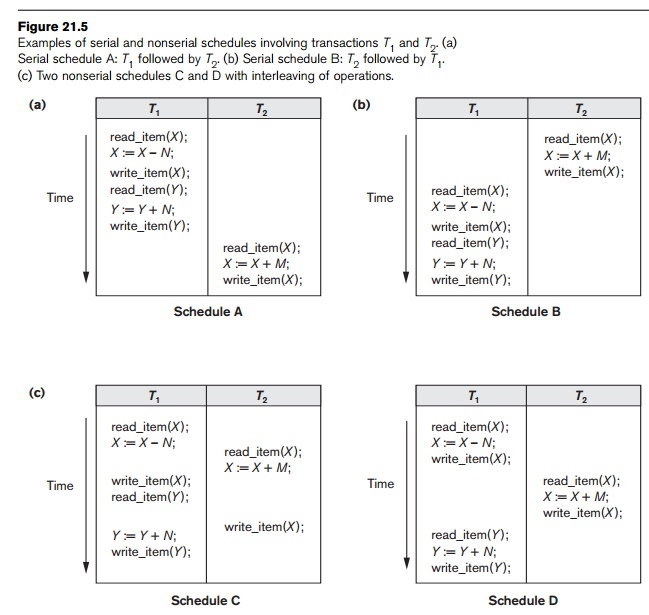
1. Serial, Nonserial,
and Conflict-Serializable Schedules
Schedules
A and B in Figure 21.5(a) and (b) are called serial because the operations of each transaction are executed
consecutively, without any interleaved operations from the other transaction.
In a serial schedule, entire transactions are performed in serial order: T1 and then T2 in Figure 21.5(a), and T2 and then T1 in Figure 21.5(b).
Schedules C and D in Figure 21.5(c) are called nonserial because each sequence interleaves operations from the two
transactions.
Formally,
a schedule S is serial if, for every transaction T participating in the schedule, all the operations of T are executed consecutively in the
schedule; otherwise, the schedule is called nonserial. Therefore, in a serial schedule, only one transaction at
a time is active—the commit (or abort) of the active transaction initiates
execution of the next transaction. No interleaving occurs in a serial schedule.
One reasonable assumption we can make, if we consider the transactions to be independent, is that every serial schedule is considered correct.
We can assume this because every transaction is assumed to be correct if
executed on its own .
Hence, it does not matter which transaction
is executed first. As long as every transaction is executed from beginning
to end in isolation from the operations of other transactions, we get a correct
end result on the database.
The
problem with serial schedules is that they limit concurrency by prohibiting
interleaving of operations. In a serial schedule, if a transaction waits for an
I/O operation to complete, we cannot switch the CPU processor to another
transaction, thus wasting valuable CPU processing time. Additionally, if some
transaction T is quite long, the
other transactions must wait for T to
complete all its operations before starting. Hence, serial schedules are considered unacceptable in practice.
However, if we can determine which other schedules are equivalent to a serial sched-ule, we can allow these schedules to
occur.
To
illustrate our discussion, consider the schedules in Figure 21.5, and assume
that the initial values of database items are X = 90 and Y = 90 and
that N = 3 and M = 2. After executing transactions T1 and T2,
we would expect the database values to be X
= 89 and Y = 93, according to the
meaning of the transactions. Sure enough, executing either of the serial
schedules A or B gives the correct results. Now consider the nonserial
schedules C and D. Schedule C (which is the same as Figure 21.3(a)) gives the
results X = 92 and Y = 93, in which the X value is erroneous, whereas schedule D
gives the correct results.
Schedule
C gives an erroneous result because of the lost
update problem discussed in Section 3; transaction T2 reads the value of X before it is changed by transaction T1, so only the effect of T2 on X is reflected in the database. The effect of T1 on X is lost, overwritten by T2, leading to the incorrect
result for item X. However, some nonserial schedules give the correct
expected result, such as schedule D. We would like to determine which of the
nonserial schedules always give a
correct result and which may give erroneous results. The concept used to
characterize schedules in this manner is that of serializability of a schedule.
The
definition of serializable schedule
is as follows: A schedule S of n transactions is serializable if it is equivalent to some serial schedule of the same n transactions. We will
define the concept of equivalence of
schedules shortly. Notice that there are n! possible serial schedules of n
transactions and many more possible nonserial schedules. We can form two
disjoint groups of the nonserial schedules—those that are equivalent to one (or
more) of the serial schedules and hence are serializable, and those that are
not equivalent to any serial schedule
and hence are not serializable.
Saying
that a nonserial schedule S is
serializable is equivalent to saying that it is cor-rect, because it is
equivalent to a serial schedule, which is considered correct. The remaining
question is: When are two schedules considered equivalent?
There are
several ways to define schedule equivalence. The simplest but least satisfactory
definition involves comparing the effects of the schedules on the database. Two
schedules are called result equivalent
if they produce the same final state of the database. However, two different
schedules may accidentally produce the same final state. For example, in Figure
21.6, schedules S1 and S2 will produce the same
final database state if they execute on a database with an initial value of X = 100; however, for other initial
values of X, the schedules are not result equivalent. Additionally, these
schedules execute different transactions, so they definitely should not be
considered equivalent. Hence, result equivalence alone cannot be used to
define equivalence of schedules. The safest and most general approach to
defining schedule equivalence is not to make any assumptions about the types of
operations included in the transactions. For two schedules to be equivalent,
the operations applied to each data item affected by the schedules should be
applied to that item in both schedules in
the same order. Two definitions of equivalence of schedules are generally
used: conflict equivalence and view equivalence. We discuss conflict
equivalence next, which is the more commonly used definition.
The
definition of conflict equivalence of
schedules is as follows: Two schedules are said to be conflict equivalent if the order of any two conflicting operations is the same in both schedules. Recall from
Section 21.4.1 that two operations in a schedule are said to conflict if they belong to different
transactions, access the same database item, and either both are write_item operations or one is a write_item and the other a read_item. If two conflicting operations
are applied in different orders in two
sched-ules, the effect can be different on the database or on the transactions
in the sched-ule, and hence the schedules are not conflict equivalent. For
example, as we discussed in Section 21.4.1, if a read and write operation occur
in the order r1(X), w2(X) in schedule S1, and in the reverse order w2(X), r1(X) in schedule S2,
the value read by r1(X) can be different in the two schedules. Similarly, if two write
operations

occur in
the order w1(X), w2(X) in S1, and in the reverse order w2(X), w1(X) in S2, the
next r(X) operation in the two schedules will read potentially different
values; or if these are the last operations writing item X in the schedules, the final value of item X in the database will be different.
Using the
notion of conflict equivalence, we define a schedule S to be conflict
serializable if it
is (conflict) equivalent to some serial schedule S . In such a case, we can
reorder the nonconflicting operations
in S until we form the equivalent
serial schedule S . According to this
definition, schedule D in Figure 21.5(c) is equivalent to the serial schedule A
in Figure 21.5(a). In both schedules, the read_item(X) of T2 reads the value of X written by T1, while the other operations read the database values from
the initial database state. Additionally, T1
is the last transaction to write Y,
and T2 is the last
transaction to write X in both
schedules. Because A is a serial schedule and schedule D is equivalent to A, D
is a serializable schedule. Notice that the operations r1(Y) and w1(Y) of schedule D do not conflict with the operations r2(X) and w2(X), since they access different data
items. Therefore, we can move r1(Y),
w1(Y) before r2(X), w2(X), leading to the equivalent serial
schedule T1, T2.
Schedule
C in Figure 21.5(c) is not equivalent to either of the two possible serial
schedules A and B, and hence is not
serializable. Trying to reorder the operations of schedule C to find an
equivalent serial schedule fails because r2(X) and w1(X) conflict,
which means that we cannot move r2(X) down to get the equivalent serial
schedule T1, T2. Similarly, because w1(X) and w2(X) conflict, we cannot move w1(X) down to get the equivalent serial schedule T2, T1.
Another,
more complex definition of equivalence—called view equivalence, which leads to the concept of view
serializability—is discussed in Section 21.5.4.
2. Testing for Conflict
Serializability of a Schedule
There is
a simple algorithm for determining whether a particular schedule is conflict
serializable or not. Most concurrency control methods do not actually test for serializability. Rather protocols, or rules,
are developed that guarantee that any schedule that follows these rules will be
serializable. We discuss the algorithm for testing conflict serializability of
schedules here to gain a better understanding of these concurrency control
protocols, which are discussed in Chapter 22.
Algorithm
21.1 can be used to test a schedule for conflict serializability. The
algorithm looks at only the read_item and write_item operations in a schedule to
construct a precedence graph (or serialization graph), which is a directed graph G = (N, E) that consists of a set of nodes N = {T1,
T2, ..., Tn } and a set of directed
edges E = {e1, e2,
..., em }. There is one
node in the graph for each transaction Ti
in the schedule. Each edge ei in the graph is of the form
(Tj → Tk ), 1 ≤ j ≤ n, 1 ≤ k f n, where Tj is the starting
node of ei and Tk is the ending node of ei.
Such an edge from node Tj to node Tk is
created by the algorithm if one of the operations in Tj appears in the schedule before some conflicting operation in Tk.
Algorithm 21.1. Testing Conflict Serializability
of a Schedule S
·
For each transaction Ti participating in schedule S, create a node labeled Ti
in the precedence graph.
·
For each case in S where Tj
executes a read_item(X) after Ti executes a write_item(X), create an edge (Ti → Tj) in the precedence graph.
·
For each case in S where Tj
executes a write_item(X) after Ti executes a read_item(X), create an edge (Ti → Tj) in the precedence graph.
·
For each case in S where Tj
executes a write_item(X) after Ti executes a write_item(X), create an edge (Ti → Tj) in the precedence graph.
The schedule S
is serializable if and only if the precedence graph has no cycles.
The
precedence graph is constructed as described in Algorithm 21.1. If there is a
cycle in the precedence graph, schedule S
is not (conflict) serializable; if there is no cycle, S is serializable. A cycle
in a directed graph is a sequence of
edges C = ((Tj → Tk), (Tk → T p), ..., (Ti → Tj)) with
the property that the starting node of each
edge—except the first edge—is the same as the ending node of the previous
edge, and the starting node of the first edge is the same as the ending node of
the last edge (the sequence starts and ends at the same node).
In the
precedence graph, an edge from Ti
to Tj means that
transaction Ti must come
before transaction Tj in
any serial schedule that is equivalent to S,
because two conflicting operations appear in the schedule in that order. If
there is no cycle in the precedence graph, we can create an equivalent serial schedule S that is equivalent to S, by ordering the transactions that
participate in S as follows: Whenever
an edge exists in the precedence graph from Ti
to Tj, Ti must appear before Tj in the equivalent serial
schedule S . Notice that
the edges (Ti → Tj) in a precedence graph can optionally be labeled by
the name(s) of the data item(s) that led to creating the edge. Figure 21.7
shows such labels on the edges.
In
general, several serial schedules can be equivalent to S if the precedence graph for S
has no cycle. However, if the precedence graph has a cycle, it is easy to
show that we cannot create any
equivalent serial schedule, so S is
not serializable. The precedence graphs created for schedules A to D,
respectively, in Figure 21.5 appear in Figure 21.7(a) to (d). The graph for
schedule C has a cycle, so it is not serializable. The graph for schedule D has
no cycle, so it is serializable, and the equivalent serial schedule is T1 followed by T2. The graphs for schedules
A and B have no cycles, as expected, because the schedules are serial and hence
serializable.
Another
example, in which three transactions participate, is shown in Figure 21.8.
Figure 21.8(a) shows the read_item and write_item operations in each transaction.
Two schedules E and F for these transactions are shown in
Figure 21.8(b) and (c),
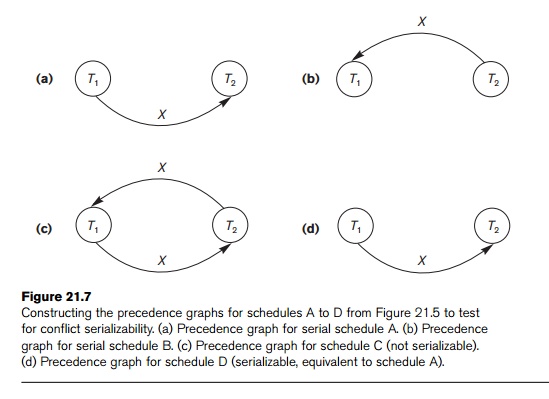
Figure 21.7
Constructing the precedence graphs for schedules A to D from Figure 21.5 to test for conflict serializability. (a) Precedence graph for serial schedule A. (b) Precedence graph for serial schedule B. (c) Precedence graph for schedule C (not serializable). (d) Precedence graph for schedule D (serializable, equivalent to schedule A).
respectively, and the precedence graphs for schedules E and F are shown
in parts (d) and (e). Schedule E is not serializable because the corresponding
precedence graph has cycles. Schedule F is serializable, and the serial
schedule equivalent to F is shown in
Figure 21.8(e). Although only one equivalent serial schedule exists for F, in general there may be more than
one equivalent serial schedule for a serializable sched-ule. Figure 21.8(f)
shows a precedence graph representing a schedule that has two equivalent serial
schedules. To find an equivalent serial schedule, start with a node that does
not have any incoming edges, and then make sure that the node order for every
edge is not violated.
3. How Serializability
Is Used for Concurrency Control
As we
discussed earlier, saying that a schedule S
is (conflict) serializable—that is, S
is (conflict) equivalent to a serial schedule—is tantamount to saying that S is correct. Being serializable is distinct from being serial, however. A serial schedule represents inefficient
processing because no interleaving of operations from different transac-tions
is permitted. This can lead to low CPU utilization while a transaction waits
for disk I/O, or for another transaction to terminate, thus slowing down
processing considerably. A serializable schedule gives the benefits of
concurrent execution without giving up any correctness. In practice, it is
quite difficult to test for the seri-alizability of a schedule. The
interleaving of operations from concurrent transac-tions—which are usually
executed as processes by the operating system—is typically determined by the
operating system scheduler, which allocates resources to
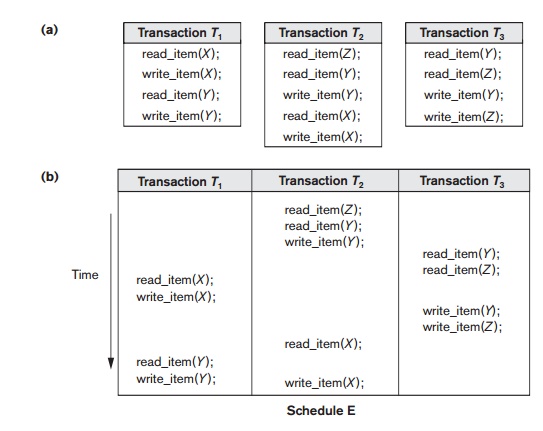
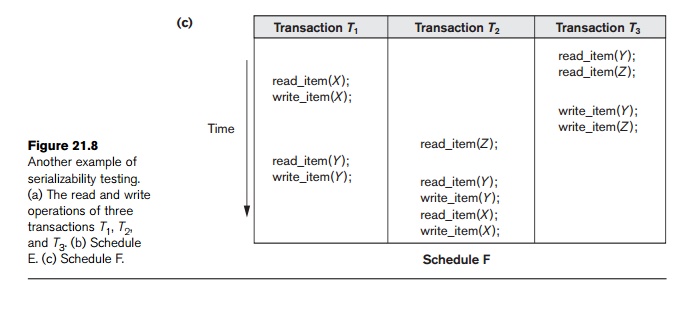
all
processes. Factors such as system load, time of transaction submission, and
priorities of processes contribute to the ordering of operations in a
schedule. Hence, it is difficult to determine how the operations of a schedule
will be interleaved before-hand to ensure serializability.
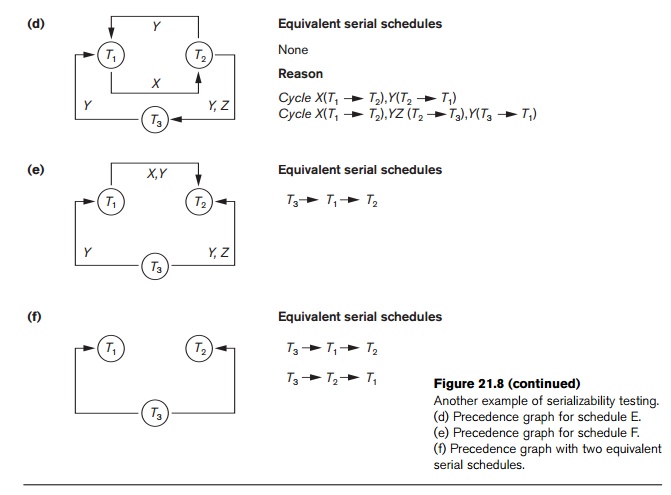
If
transactions are executed at will and then the resulting schedule is tested for
serializability, we must cancel the effect of the schedule if it turns out not
to be serializable. This is a serious problem that makes this approach
impractical. Hence, the approach taken in most practical systems is to
determine methods or protocols that ensure serializability, without having to
test the schedules themselves. The approach taken in most commercial DBMSs is
to design protocols (sets of rules)
that—if fol-lowed by every individual
transaction or if enforced by a DBMS concurrency control subsystem—will ensure
serializability of all schedules in which
the transactions participate.
Another
problem appears here: When transactions are submitted continuously to the
system, it is difficult to determine when a schedule begins and when it ends.
Serializability theory can be adapted to deal with this problem by considering
only the committed projection of a schedule S.
Recall from Section 21.4.1 that the committed
projection C(S) of a schedule S includes only the operations in S that belong to committed transactions. We can theoretically define a
schedule S to be serializable if its
committed projection C(S) is equivalent to some serial
schedule, since only committed transactions are guaranteed by the DBMS.
In
Chapter 22, we discuss a number of different concurrency control protocols that
guarantee serializability. The most common technique, called two-phase locking, is based on locking
data items to prevent concurrent transactions from interfering with one
another, and enforcing an additional condition that guarantees
serializability. This is used in the majority of commercial DBMSs. Other
protocols have been proposed;14 these include timestamp ordering, where each transaction is assigned a unique
timestamp and the protocol ensures that any conflicting opera-tions are
executed in the order of the transaction timestamps; multiversion protocols, which are based on maintaining multiple
versions of data items; and optimistic
(also called certification or validation) protocols, which check for possible serializability violations
after the transactions terminate but before they are permitted to commit.
4. View Equivalence and
View Serializability
In
Section 21.5.1 we defined the concepts of conflict equivalence of schedules and
conflict serializability. Another less restrictive definition of equivalence of
schedules is called view equivalence.
This leads to another definition of serializability called view serializability. Two schedules S and S are said to be view
equivalent if the fol-lowing
three conditions hold:
1. The same set of transactions participates in S and S , and S and S include the same operations of those transactions.
2. For any operation ri(X) of Ti in S, if the value of X read by the operation has been written by an operation wj(X) of Tj (or if it is the original value of X before the schedule started), the same condition must hold for the value of X read by operation ri(X) of Ti in S .
3. If the operation wk(Y) of Tk is the last operation to write item Y in S, then wk(Y) of Tk must also be the last operation to write item Y in S .
The idea
behind view equivalence is that, as long as each read operation of a
trans-action reads the result of the same write operation in both schedules,
the write operations of each transaction must produce the same results. The
read operations are hence said to see the
same view in both schedules. Condition 3 ensures that the final write
operation on each data item is the same in both schedules, so the data-base
state should be the same at the end of both schedules. A schedule S is said to be view serializable if it is view equivalent to a serial schedule.
The
definitions of conflict serializability and view serializability are similar if
a condition known as the constrained
write assumption (or no blind writes)
holds on all transactions in the schedule. This condition states that any write
operation wi(X) in Ti is preceded by a ri(X) in Ti and that the value written by wi(X) in Ti depends only on the value
of X read by ri(X). This
assumes that computation of the new value of X is a function f(X) based on the old value of X read from the database. A blind write is a write operation in a
transaction T on an item X that is not dependent on the value of
X, so it is not preceded by a read of
X in the transaction T.
The
definition of view serializability is less restrictive than that of conflict
serializability under the unconstrained
write assumption, where the value written by an operation wi(X) in Ti can
be independent of its old value from the database. This is possible when blind writes are allowed, and it is
illustrated by the following schedule Sg
of three transactions T1: r1(X); w1(X);
T2: w2(X); and T3: w3(X):
Sg: r1(X); w2(X); w1(X);
w3(X); c1; c2; c3;
In Sg the operations w2(X) and w3(X) are blind writes, since T2 and T3 do not read the value of X. The schedule Sg
is view serializable, since it is view equivalent to the serial schedule T1, T2, T3.
However, Sg is not
conflict serializable, since it is not conflict equivalent to any serial
schedule. It has been shown that any conflict-serializable schedule is also view
serializable but not vice versa, as illustrated by the preceding example. There
is an algorithm to test whether a schedule S
is view serializable or not. However, the problem of testing for view
serializability has been shown to be NP-hard, meaning that finding an efficient
polynomial time algorithm for this problem is highly unlikely.
5. Other Types of
Equivalence of Schedules
Serializability
of schedules is sometimes considered to be too restrictive as a condition for
ensuring the correctness of concurrent executions. Some applications can
produce schedules that are correct by satisfying conditions less stringent than
either conflict serializability or view serializability. An example is the type
of transactions known as debit-credit
transactions—for example, those that apply deposits and withdrawals to a
data item whose value is the current balance of a bank account. The semantics
of debit-credit operations is that they update the value of a data item X by either subtracting from or adding
to the value of the data item. Because addition and subtraction operations are
commutative—that is, they can be applied in any order—it is possible to produce
correct schedules that are not serializable. For example, consider the
following transactions, each of which may be used to transfer an amount of
money between two bank accounts:
T1: r1(X); X := X − 10; w1(X); r1(Y); Y := Y + 10; w1(Y); T2: r2(Y); Y :=
Y − 20; w2(Y); r2(X);
X := X + 20; w2(X);
Consider
the following nonserializable schedule Sh
for the two transactions: Sh: r1(X); w1(X);
r2(Y); w2(Y); r1(Y);
w1(Y); r2(X); w2(X);
With the
additional knowledge, or semantics,
that the operations between each ri(I) and wi(I) are
commutative, we know that the order of executing the sequences consisting of
(read, update, write) is not important as long as each (read, update, write)
sequence by a particular transaction Ti
on a particular item I is not
interrupted by conflicting operations. Hence, the schedule Sh is considered to be correct even though it is not
serializable. Researchers have been working on extending concurrency control
theory to deal with cases where serializability is considered to be too
restrictive as a condition for correctness of schedules. Also, in certain
domains of applications such as computer aided design (CAD) of complex systems
like aircraft, design transactions last over a long time period. In such
applications, more relaxed schemes of concurrency control have been proposed to
maintain consistency of the database.
Related Topics